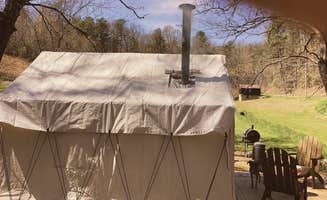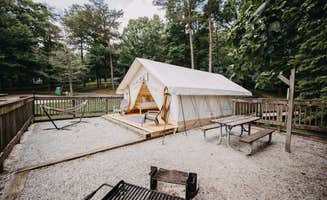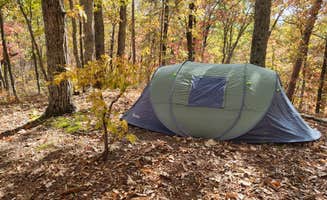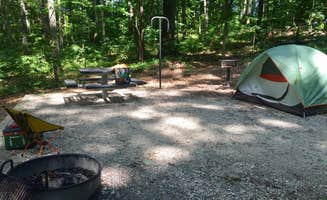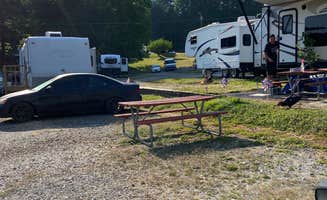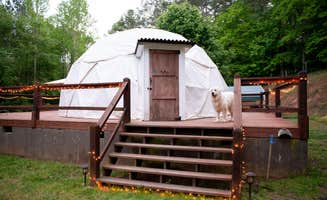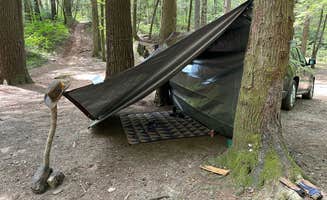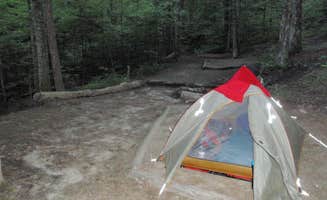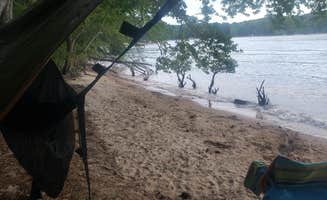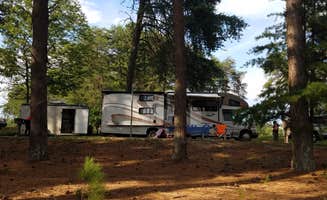Camping spots near Nelson, Georgia range from elevations of 700 to 2,800 feet, providing significant temperature variations between campgrounds. The forested foothills create natural windbreaks at many sites, with average summer nighttime temperatures dropping to 65°F at higher elevations. Most campgrounds in the area experience peak occupancy during October's leaf season when reservation windows open 13 months in advance.
What to do
Water activities beyond swimming: At Bald Ridge Creek on Lake Lanier, campers can explore the lake's countless coves by kayak. "We like to kayak to islands, collect rocks and take lots of pictures. Water is warm, a little muddy by shore but clear as you get further out," notes Christy C. The lake supports multiple water activities simultaneously due to its size.
Hiking with elevation gain: Winter hikes provide clearer views across valleys. At Fort Mountain State Park, trails offer significant elevation changes with historic features. "The fire tower is a vision. To think that young men came and worked and set every stone step you walk on to get to the tower is an amazing feat of engineering," shares Elaine G. Most hiking trails remain open year-round, though some close after heavy rainfall.
Wildlife observation: Early morning offers the best wildlife viewing hours. "We had bear visitors, something they'll warn you about upon arrival. The bears just added to the appeal of this place though," reports Shelly C. about Fort Mountain State Park. Deer sightings occur frequently at dawn and dusk, particularly near water sources across multiple campgrounds.
What campers like
Lake proximity: Waterfront sites consistently rank highest in reservations. At Sweetwater Campground, sites directly on the water provide easy access. "We always stay on site 100 it's right on the water," says Mary B. Sites with water views typically cost $5-10 more per night but offer immediate lake access for fishing and swimming.
Privacy between sites: Wooded areas create natural screening between campsites. "The sites are color coded depending on size and there is even a yurt to rent," explains Suzy E. about Red Top Mountain State Park. Loop layouts vary significantly in site spacing, with older campgrounds typically providing more substantial vegetation between spots.
Accommodations beyond tents: Several campgrounds offer structural alternatives for campers without equipment. "Loved hiking here and the cabins are awesome," writes Debbie S. about Amicalola Falls State Park. Platform sites at Fort Mountain provide a middle ground between tents and cabins, with raised wooden platforms at $10-15 less than cabin options.
What you should know
Steep access roads: Many campgrounds require navigating significant inclines. "I read a lot before my trip, so I knew to except the 25% grade incline going up to the campground. I wasn't however expecting the challenging parking in the campsite," notes Traci C. about Amicalola Falls. Larger trailers should check specific campground road conditions before booking.
Bathroom distribution: Facility locations impact site selection at larger campgrounds. "The only downfall is there are only 2 bathroom sites so choose campsite accordingly," advises Peter N. about Bolding Mill. Most bathhouses close for cleaning between 10am-noon daily.
Gate closure times: After-hours arrivals face additional logistics. At Doll Mountain Campground, gates secure the area overnight. "Gate is locked at 10:30 PM; after that you have to park outside the entrance and walk to your site," explains Craig J. Many campgrounds implement similar security measures with varying lockdown schedules.
Tips for camping with families
Beach access considerations: Swimming areas vary significantly in size and quality. "This campground has a beautiful big beach! Boat ramps also," shares Lauren W. about Victoria Campground. Some beaches close midweek during shoulder season (April-May and September-October).
Playground proximity: Not all campgrounds include play equipment. "The playground is crummy," notes Nancy K. about Bolding Mill, highlighting the importance of checking for recreational facilities when booking. Sites within visual distance of playgrounds allow parents to supervise from their campsite.
Kid-friendly exploration: Natural features often engage children more than constructed facilities. At Diamond Lure Campground, "The grounds are clean and maintained with water and power at all or nearly all spots. Scenery is wooded and rustic with a tranquil lake on the property," according to Donald G. Many campgrounds offer junior ranger programs during summer months, providing structured activities for younger campers.
Tips from RVers
Site angles: Backing into spaces requires careful assessment. "Back in is not straight so it takes a little bit of maneuvering (that maybe why it was one of the last few sites available a week out)," explains Kevin Z. about Bolding Mill. Corner sites typically provide more maneuvering room but may have less privacy.
Dump station timing: Sunday departures create bottlenecks at single-station facilities. "Single dump station tends to line up on Sunday but I suppose that's part of the deal," shares AR M. about Bolding Mill. Some campgrounds now offer scheduled dump times to reduce waiting periods.
Site leveling challenges: Natural terrain creates uneven sites throughout the region. "The site had about a 5 inch difference shopping towards the road. I used rocker blocks maxed out (about 4 inches in height) and still was not level," reports Mike N. about Fort Mountain State Park. Most campgrounds do not publish leveling information beyond general site descriptions.


